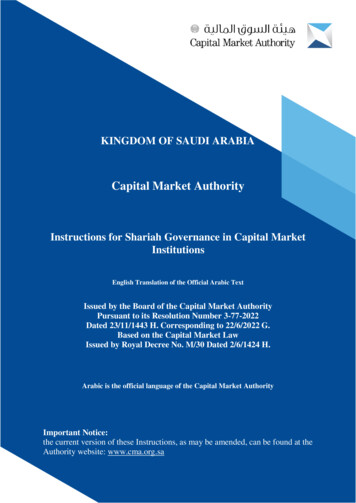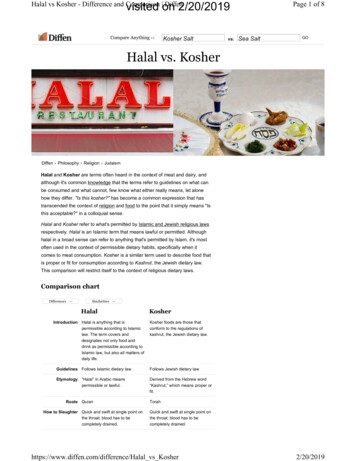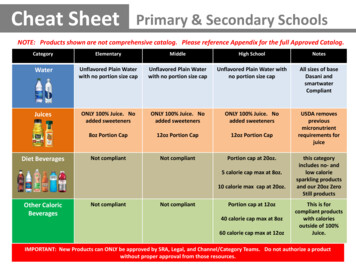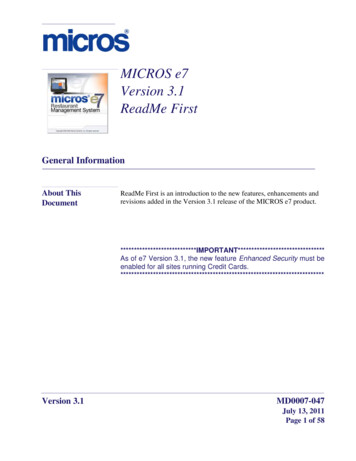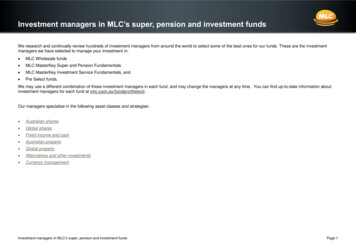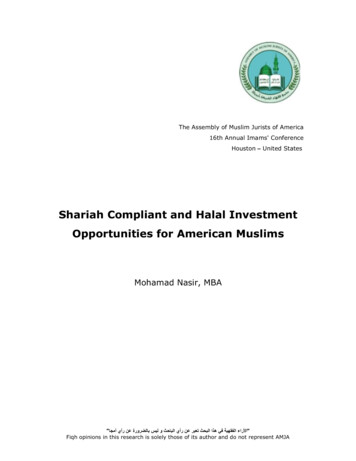
Transcription
The Assembly of Muslim Jurists of America16th Annual Imams' ConferenceHouston – United StatesShariah Compliant and Halal InvestmentOpportunities for American MuslimsMohamad Nasir, MBA" "األراء الفقهية في هذا البحث تعبر عن رأي الباحث و ليس بالضرورة عن رأي أمجا Fiqh opinions in this research is solely those of its author and do not represent AMJA
Shariah Compliant and Halal Investment Opportunities for American MuslimsMohamad NasirContentsAbstract . 4Introduction . 5The Importance of Retirement Planning . 6Retirement Plans . 8Qualified Retirement Plans . 8401(k) Retirement Plans . 9403(b) Retirement Plans . 9Traditional IRA . 9Roth IRA . 10Roll Over IRA . 10Unqualified Retirement Plans . 10457 Plan . 11529 Plans . 11Coverdell Educational Savings Account . 12Health Savings Account (HSA) . 12Investment into Stocks . 13Investment into Mutual Funds. 13Ethical & Shariah Compliant Investments . 14Shariah-Compliant Company . 14Purification . 17Zakat . 17Conclusion. 20References . 21List of Figures . 233AMJA 16th Annual Imams' Conference Contemporary Financial Issues (Buying Real Estate and Retirement Accounts) Mar 1st-3rd 2019
Shariah Compliant and Halal Investment Opportunities for American MuslimsMohamad NasirAbstractRetirement planning is a serious topic that is often neglected by all of us. Regardless of ourage, we should all consider retirement planning as early as possible. Retirement planningtakes care of our lifestyle when we decide to finish work or exit the business.This paper will address the retirement plans available plus attempt to provide Imams andparticipants of the AMJA Conference with a holistic view of the investment universe in theUnited States. The paper gives an insight into the basic knowledge of investing, types ofaccounts available to investors, and the shariah component as well touch on the purificationof the investment and the methods of Zakat on investments.4AMJA 16th Annual Imams' Conference Contemporary Financial Issues (Buying Real Estate and Retirement Accounts) Mar 1st-3rd 2019
Shariah Compliant and Halal Investment Opportunities for American MuslimsMohamad NasirIn the name of Allah, the Most Merciful, the Grantor of MercyIntroductionImam Ahmed and Al-Tirmithi and narrated by Abdullah Ibn Busr reads as follows: ‘TheMessenger of Allah (May Allah’s Salat and Peace be upon him) said, “The best of mankind ishe who lives long and performs good deeds.”Preparing for retirement is not something that we think about every day. In simplisticterms, we can either do nothing and let our savings grow through regular savings accountsor seriously think about our retirement plans now. Regular savings accounts will not helpyou during your retirement years. The regular savings accounts cannot maintain thepurchasing power over time and there are no tax advantages to you.This paper will address the retirement plans available for people to understand retirementplanning and investment in general the American Muslim community experience in theUnited States. The paper will attempt to provide Imams with a holistic view of theinvestment universe in the United States. The paper gives an insight into the basicknowledge of investing, types of accounts available to investors, and the shariah componentas well touch on the purification of the investment and the methods of Zakat oninvestments.The Shariah component of these investments in retirement plans will be reviewed coupledwith a predominant view of the Shariah component with differences among the differentstandards widely used around the world and the United States. Hence, the paper is notdesigned to address the detailed Scholarly opinion on the Shariah permissibility ofinvestments through stocks and mutual funds.5AMJA 16th Annual Imams' Conference Contemporary Financial Issues (Buying Real Estate and Retirement Accounts) Mar 1st-3rd 2019
Shariah Compliant and Halal Investment Opportunities for American MuslimsMohamad NasirThe Importance of Retirement PlanningCato the Elder is quoted saying, Cessation of work is unaccompanied by cessation ofexpenses. With most people being employees, contractors or small business owners, thelack of retirement planning poses a high risk for these people during retirement with little orno income and therefore must either rely on immediate family for financial assistance,charity, or government assistance.Retirement planning is important to everyone. Retirement planning provides financialstability when retirement happens. Retirement planning gives people the opportunity toenjoy a lifestyle they desire and to cover the increasing medical bills that comes with oldage.A retirement plan is a strategic plan that contains many tools and resources designed toprovide financial stability for life in retirement. The retirement plan will comprise twodistinct areas. The first is the account vehicle that is utilized for retirement or investment.Most if not all these vehicles are Halal such as IRAs, 401(k)s or an ordinary investmentaccount. The second is the investment plans for these vehicles such as stocks, mutual fundsor other investment opportunities that may be considered. Each type investment plan willhave different advantages and disadvantages. Professional advice should be consideredwhen selecting the investment tools needed for the retirement plan or consider do ityourself (DIY) research is another option and less costly. The professional advice will befocused upon the person’s expected needs, tolerance for risk, and available funds.Retirement planning can begin at any age, ideally as early as possible. Early retirementplanning offers great rewards plus reduces stress on the lives of people in later years. Let uslook at an example of Nicole and Ted.6AMJA 16th Annual Imams' Conference Contemporary Financial Issues (Buying Real Estate and Retirement Accounts) Mar 1st-3rd 2019
Shariah Compliant and Halal Investment Opportunities for American MuslimsMohamad NasirFigure 1 - Example of Retirement PlanningNicole commences her retirement planning at age 30. Over a ten-year period, shecontributes 450 a month to an IRA equating to 54,000. She leaves her money in the IRAuntil she retires. At the retirement age of 67 years, her IRA has generated total earnings of 654,484 plus her contributions has given Nicole a nice amount of 713,484 to retire.Yet, Ted does not start his retirement planning until he turns 40. Ted made contributions of 450 a month to his employer’s 401(k) plan for 27 years until he retires at age 67. After 27years, Ted can access 517,045. This assumes both savers earn an average annual returnof 8% on their retirement money.The impact of starting early with a retirement plan is shown in Figure 1. Nicole’s 10-yearhead start gave her a distinct advantage over Ted, even though she contributed less thanhalf the amount he did.Pocket Sense state that financial planners estimate that a person in retirement will needabout a three-fourths of their pre-retirement income per year for at least 20 years. Forexample, if a person was earning 50,000 per year and life in retirement years wasestimated at 20 years, the person would need about 750,000 put away for retirement.(Kennan, 2017)7AMJA 16th Annual Imams' Conference Contemporary Financial Issues (Buying Real Estate and Retirement Accounts) Mar 1st-3rd 2019
Shariah Compliant and Halal Investment Opportunities for American MuslimsMohamad NasirRetirement PlansRetirement plans are categorized into qualified and unqualified retirement investment plans.What is the difference between the two types of retirement plans? According to Zacks, aqualified retirement plan is a plan that is regulated by Employee Retirement IncomeSecurity Act (ERISA). Non-qualified retirement plans are not regulated by ERISA and can beused as part of a salary package for executives and other highly compensated employees.(Zacks, 2018)To address the issue of retirees being without income, the U.S. Government has providedincentives for qualified retirement investment plans. Examples of qualified retirement plansinclude 401(k), 403(b), Traditional IRA, Roth IRA, Roll Over IRA, SEP IRA, and SIMPLE IRA.It is important to beware of not all retirements plans are qualified. Some investment plansare not qualified and, thus, not regulated by the ERISA. Examples of unqualified retirementplans are the 457 and 529 plans (college savings plans).This paper will outline the qualified and unqualified retirement plans plus the CoverdellEducational Savings Account and Health Savings Accounts for the benefit of the reader.Qualified Retirement PlansThe Employee Retirement Income Security Act of 1974 (ERISA) passed by U.S. Congressregulates the qualified retirement plan by setting of minimum standards for most voluntarilyqualified retirement and health plans. The purpose of this Act is to provide protection forindividuals by providing for their retirement in the private industry plans. The tax breakincentives offered by this Act are designed to encourage employers to make contributionsthat are made for their employees to the qualified retirement plans.Beware of non-qualified plans as they do not meet the ERISA guidelines for eligibility,participation, and other criteria. (US Department of Labor, 1974) More information on nonqualified plans are given later in this paper.Qualified retirement plans are classified into two groups of plans: defined benefit plans anddefined contribution plans. The difference between the two types of funds are explained. Adefined benefit plans sets out a prescribed amount of payout for the individual. The amountprescribed is a guaranteed amount. The defined benefit plan is becoming less popular thanthe defined contribution plans. (US Department of Labor)The more popular defined contribution plan is a retirement plan in which regular paymentsare made by the employer and/or employee. In likeliness, the employer will match thepayment made by the employee which is typically a predetermined amount of pre-tax8AMJA 16th Annual Imams' Conference Contemporary Financial Issues (Buying Real Estate and Retirement Accounts) Mar 1st-3rd 2019
Shariah Compliant and Halal Investment Opportunities for American MuslimsMohamad Nasirearnings. The value of monies held within these retirement plans will fluctuate dependingupon the investment criteria and market conditions.The highly recognized 401(k) is the most common type of defined contribution plan. Otherdefined contribution plans include 403(b) plans, employee stock ownership plans, andprofit-sharing plans. (US Department of Labor, 2019)401(k) Retirement PlansA 401(k)-retirement plan is a qualified employer-sponsored retirement plan based upon therequirements of ERISA. The retirement plan is for the benefit of the employee. (Kagan,2018)Eligible employees may make salary-deferral contributions to the 401(k)-retirement plan ona post-tax and/or pretax basis. The contribution to the 401(k) is limited to a certainpercentage of an employee’s salary, and it has a maximum contribution level. The employermay elect to partially match or fully match the contribution on behalf of the employees;however, the Internal Revenue Service regulates the fund by placing limits on thepercentage of salary-deferral contributions. The earnings generated by the 401(k) planaccrue on a tax-deferred basis.403(b) Retirement PlansThe 403(b) Retirement Plan is a tax advantaged retirement investment fund that wasestablished primarily for employees of public schools, ministers, and employees of sometax-exempt organizations. There are three types of plans available namely (a) an annuitycontract provided by insurance company, (b) a custodial account that invest in mutual fundsand (c) a retirement income account set up for Masjid (Church) employees. The investmentcriteria for the 403(b) plans is either mutual funds or annuities. (Internal Revenue Service,2019)There is a cap on Contributions to the 403(b) plans. If contributions exceed the capped levelas regulated by the Internal Revenue Service, then penalties apply. The limit on annualcontributions is capped at 56,000 for 2019 year. (Internal Revenue Service, 2019)Traditional IRAA traditional IRA is an individual retirement account (IRA) designed to give individuals theopportunity to save for retirement. There can be significant tax advantages for individualswho make contributions to this type of retirement plan. The contributions made to atraditional IRA are made from pre-tax dollars and may be partial or fully tax deductibledepending upon the individual’s circumstances. The earnings and gains accrued in thetraditional IRA are not taxed until they are distributed. (Internal Revenue Service, 2018)(Internal Revenue Service, 2018)9AMJA 16th Annual Imams' Conference Contemporary Financial Issues (Buying Real Estate and Retirement Accounts) Mar 1st-3rd 2019
Shariah Compliant and Halal Investment Opportunities for American MuslimsMohamad NasirRoth IRAThe Roth IRA has many similarities to the traditional IRA. Contributions made to the RothIRA is made from after-tax income. Individuals can still make contributions to Roth IRAafter the age of 70 years providing that they are still earning income.The primary differences between a Roth IRA and traditional IRA retirement plan are that (a)the earnings and growth in the Roth IRA are tax-free and (b) distributions or withdrawalsfrom the Roth IRA is tax-free. (Malone, 2018)Roll Over IRAA rollover Individual Retirement Account (IRA) is an account that has been designed toallow for transfer of assets from an earlier employer-sponsored retirement account to atraditional IRA. The rollover IRA from a 401(k), 403(b) or profit-sharing plan enjoys thestatus of maintaining the status of tax-deferred assets. Using the direct rollover method,the employer directly transfers the assets and the employees avoid having 20% of theirtransferred assets withheld by the Internal Revenue Service which is different from anindirect rollover. The indirect rollover allows for the employee to take possession of theretirement plan assets. The employee has 60 days to rollover the assets into an eligibleretirement plan. In the indirect rollover method, 20% of the account’s assets may bewithheld. Upon the employee filing their annual tax return, the 20% of the assets areunlocked and transferred to the eligible retirement fund. (Kagen, 2018)Similarly, the assets held in the rollover IRA funds can be moved to a new employer'sretirement plan. Rollover IRA funds allow transfers into and out of the fund.There are no capping limits applied to the rollover IRAs to which an employee can roll over.The employee is permitted to invest in stocks, bonds, ETFs and mutual funds.Unqualified Retirement PlansAs stated earlier in this paper, an unqualified retirement plan is a type of tax-deferred,employer-sponsored retirement plan that is not regulated by Employee Retirement IncomeSecurity Act (ERISA). The unqualified retirement plans are typically used as an incentive forimproved performance by executives of an organization. These plans form part of anexecutive’s salary package and is an added benefit in addition to the qualified retirementplan.Contributions to a non-qualified plan do not become tax deductible to the employer until theemployee has taken a distribution from the plan for which the employee will be taxed.10AMJA 16th Annual Imams' Conference Contemporary Financial Issues (Buying Real Estate and Retirement Accounts) Mar 1st-3rd 2019
Shariah Compliant and Halal Investment Opportunities for American MuslimsMohamad Nasir457 PlanThe 457 plan is a non-qualified retirement plan that is available for governmental andcertain non-governmental employers. Independent contractors can participate in the 457plans whereas they cannot participate in the qualified 401(k) and 403(b) plans.The 457 plan is available in two types – (a) 457(b) which is offered to state and localgovernment employees and (b) 457(f) which is offered to highly compensated governmentand select non-government employees.Employees are allowed to defer up to 100% of compensation not exceeding the applicabledollar limit for the year. If the plan does not meet statutory requirements, the assets maybe subject to different rules.The plan is considered to be a tax advantaged deferred-compensation retirement plan. Theemployer provides the plan, and the employee defers compensation into it on a pre-tax orafter-tax (Roth) basis. This plan works in the same manner as a 401(k) or 403(b) plan. Thekey difference with this plan is that there is no 10% penalty if withdrawals are made if theindividual is under the 55 years. Any withdrawals made from this plan will attract ordinaryincome tax.529 PlansU.S. Securities and Exchange Commission (SEC) state that a “529 plan is a tax-advantagedsavings plan designed to encourage saving for future education costs.” (U.S. Securities andExchange Commission , 2018) The 529 plans are qualified tuition plans that are sponsoredby all states and educational institutes. The 529 plans are authorized and regulated bySection 529 of the Internal Revenue Code. Two types of 529 plans exist – education savingsplan and prepaid tuition fees.The tax-advantaged savings 529 plans do offer special tax benefits. In essence, thesummary details are shown, but these details can change depending upon the type of 529plan and the state.Contributions. Many states offer tax benefits for contributions to a 529 plans such asdeducting contributions from state income tax.Withdrawals. 529 account withdrawals used for qualified higher education expenses ortuition for elementary or secondary schools are not subject to federal income tax and, inmany cases, state income tax. If 529 account withdrawals are not used for qualified highereducation expenses or tuition for elementary or secondary schools, they will be subject tostate and federal income taxes, and an additional 10% federal tax penalty on earnings.The earnings generated in a 529 plan are tax-free earnings.11AMJA 16th Annual Imams' Conference Contemporary Financial Issues (Buying Real Estate and Retirement Accounts) Mar 1st-3rd 2019
Shariah Compliant and Halal Investment Opportunities for American MuslimsMohamad NasirCoverdell Educational Savings AccountAccording to the Internal Revenue Service, a Coverdell education savings account (CoverdellESA) is a trust or custodial account designed to pay education expenses for the nominatedbeneficiary. Like most accounts, there are certain requirements that need to be addressedwhen setting up and maintaining a Coverdell Educational Savings Account. Therequirements for this account are listed below. The nominated beneficiary must be under 18 years of age. The nominated beneficiary can be a special needs beneficiary. The account must be a Coverdell ESA when established. The document that regulates the Coverdale ESA must be in writing. Amounts held in this account must be distributed to the beneficiary by the age of 30years unless the beneficiary is a special needs beneficiary.Contributions must not exceed 2,000 per year. The contributions to the CoverdellEducational Savings Account are not tax deductible; Hence, distributions are tax-free for thenominated beneficiary if the distributions from the account are used to pay for educationalexpenses on the basis that the distributions do not exceed the limit of the beneficiary'seducation expenses. A portion of the Coverdell Educational Savings Account’s earningsbecome taxable if the distributions do exceed the beneficiary's education expenses.(Internal Revenue Service, 2018)Health Savings Account (HSA)A Health Savings Account (HSA) is an account owned by the individual to the purpose ofsaving for medical expenses that are not covered by high-deductible health plans (HDHPs).A Health Savings Account (HSA) is different from company-owned Health ReimbursementArrangements (HRA) for the simple purpose of the account is owned by the individual andthe company. The HSA funds can be used to pay for certain medical expenses withoutfederal tax liability or penalty. The contributions made to HAS funds are made out of pre-taxincome. By using untaxed dollars in a Health Savings Account (HSA), an individual canreduce their overall health care costs. (U.S. Centers for Medicare & Medicaid Services,2018)The HSA account can be created if the individual has a High Deductible Health Plan (HDHP)with a deductible limit for individual of 1,350 and families of 2,700. Limits are placed onthe contributions made into the account. The contribution limits are up to 3,450 for selfonly HDHP coverage for individuals and up to 6,900 for family HDHP coverage. If the funds12AMJA 16th Annual Imams' Conference Contemporary Financial Issues (Buying Real Estate and Retirement Accounts) Mar 1st-3rd 2019
Shariah Compliant and Halal Investment Opportunities for American MuslimsMohamad Nasirare not spent by the end of the year, the balance of the account is rolled over to the nextyear. The earnings generated in the HSA account are tax-free.Investment into StocksIn this section of the paper, we will review the basics of investing into stocks.Stocks can also be referred to as shares, securities, or equities. Stocks are individual sharesin a company. When an investor is investing into a company’s stocks, they are taking apercentage ownership of that company. If the company is a public company, then theshares are traded on a stock exchange between investors and intermediaries. Investmentinto stocks can be a good long-term investment particularly if the investor has a portfolio ofshares. A portfolio of stocks can give a smoother long-term performance rather thanbearing the ups and downs of individual stocks. An investor who is looking for short-termreturns bears more risk as the market is more unpredictable.The stock market is where buyers and sellers meet to decide on the price to buy or sellsecurities. Stocks that are traded on the stock exchange are typically purchased through abroker dealer or financial advisor. A broker dealer is an entity that will facilitate thepurchase and selling of stocks and other financial securities. A financial advisor will performthe same functions directly or indirectly through the broker dealer plus they provideguidance to managing an investor’s portfolio.Investment into Mutual FundsA mutual fund is a company that pools funds from investors for the purpose of making areturn. The investor who invests into a mutual fund owns a portion of the company plus theincome that is generated from the investments subject to the level of shares held in themutual fund. The monies held in a mutual fund is invested into securities such as stocks,bonds, and short-term debt. Mutual funds provide liquidity and diversification for investors.The purchase of share units can be done directly with the Mutual fund, or indirectly througha participating broker dealer or a financial advisor. For the purpose of this paper, purchasinga share in a Mutual fund is the same as purchasing stocks in a company when it is related toretirement accounts and Shariah Compliance.In the U.S., there are three Halal Funds - Amana, Azad, and Iman Fund. There are otherfinancial companies that are Registered Investment Advisors (RIA) which are also Shariahcompliant such as Shariah Portfolio, Wahed Invest, and Andalus Capital. Azzad is also afinancial advisor.13AMJA 16th Annual Imams' Conference Contemporary Financial Issues (Buying Real Estate and Retirement Accounts) Mar 1st-3rd 2019
Shariah Compliant and Halal Investment Opportunities for American MuslimsMohamad NasirEthical & Shariah Compliant InvestmentsQualified and unqualified retirement plans offered by most employers are available forAmerican Muslims to participate in. To date, the lack of participation into these funds byAmerican Muslims has been greatly associated with limited or lack of information coupledwith the lack of Shariah compliant investment opportunities.Individual scholars had permitted investing in companies prior to 1992. In 1992, the FiqhAcademy of the Organization of Islamic Cooperation (IIFA-OIC) organized the Fatwa(opinion) in a resolution permitting the participation of investor in purchasing stocks ofcompanies that were deemed Shariah Compliant. The Muslim World League (MWL) followedthe IIFA-OIC in permitting stock trading in 1995.Accounting and Auditing Organization for Islamic Financial Institutions (AAOIFI) wasfounded in 1990 as a not-for-profit organization. The organization is headquartered inBahrain and maintains internationally renowned scholars. The purpose of the Institution wasto maintain and promote Shariah standards for Islamic financial institutions. AAOIFI hasstandardized the resolution that was passed by the Organization of Islamic Cooperation(IIFA-OIC) through the development of standards that was to be adopted by all participants.AAOIFI plays an important role in ensuring that participants conform to the ComplianceStandards set out in Islamic finance.Since then, other institutions including the Dow Jones, S & P, FTSE, MSCI, and SC Malaysiahave established their own criteria.Shariah-Compliant CompanyA Shariah-compliant company is governed by the requirements of Shariah law and theprinciples of the Muslim religion. (Chan, 2017) These investment funds are considered to besocially responsible investing. The justification of the permissibility is based the Shariahprincipal of removing hardship from the public (AAOIFI 2015). This paper will detail theguidelines for what constitutes a Shariah Compliant company. This paper will not discussthe Fiqh aspect of how Scholars attained the Fatwa on what is considered permissible or notbut to the conclusion of their Fatwa and understanding. It is known that each of thedifferent Shariah compliant Indexes (Dow Jones, S & P, FTSE, MSCI and SC Malaysia) usesimilar Fiqh understanding but follow different guidelines.Shariah-compliant investment opportunities are well-positioned to take advantage of thegrowth of ethical and sustainable investing. Islamic finance is ethical and has similaritieswith Ethical, Social, and Governance (ESG) and Sustainable Responsible Investing (SRI)14AMJA 16th Annual Imams' Conference Contemporary Financial Issues (Buying Real Estate and Retirement Accounts) Mar 1st-3rd 2019
Shariah Compliant and Halal Investment Opportunities for American MuslimsMohamad Nasirguidelines for other investment funds. As the growth continues, it will be seen that thefuture will offer more Islamic finance products that are also ethical and sustainable.The criteria to be Shariah-compliantThe primary objective of Shariah-compliant investments is to provide an alternative optionfor investors who wish to abide to the Shariah requirements on their investments.For an investment fund that wishes to become Shariah-compliant, these funds have manyrequirements that must be addressed and monitored. A Shariah-compliant fund does notinclude investments which generate most of their income from the selling of weapons,military equipment, alcohol, pork products, pornography, or gambling. The investment fundmust have an annual Shariah audit. (Chan, 2017)This paper will now take a look at the five conditions that must be passed by an investmentfund in order for it to be considered shariah-compliant.A. The Core business of the company is permissible but excludes those institutionswhose predominant source of income is derived from conventional finance,gambling, liquors, pork and other products and services that may constituteimpermissible income. The Quran says, “O you who believe, do not wrongfullyconsume each other’s wealth” (4:29,
A 401(k)-retirement plan is a qualified employer-sponsored retirement plan based upon the requirements of ERISA. The retirement plan is for the benefit of the employee. (Kagan, 2018) Eligible employees may make salary-deferral contributions to the 401(k)-retirement plan on a post-tax and/or pretax basis.

